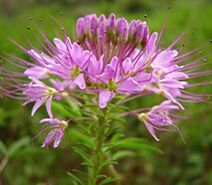Cleome serrulata
| Cleome serrulata | |
 | |
| Light: | |
| Moisture: | |
| Soil pH: | 5.6-8.4 |
| Height: | 3' |
| Blooms: | Mid Summer-Late Summer |
| Native to: | |
| Shelter | |
| Edible Rating: | |
| Medicinal Rating: | |
| Tea: | Yes |
Cleome serrulata (common name: Rocky Mountain beeplant)
Propagation: Seed - surface sow or only lightly cover the seed in spring in a greenhouse[1]. The seed usually germinates in 5 - 14 days at 25°c[1]. When large enough to handle, prick the seedlings out into individual pots and plant them out in late spring. Day time temperatures below 20°c depress germination but a night time fall to 20° is necessary[1].
Cultivation: Prefers a light fertile soil in a warm dry sunny position with plenty of room to spread[2].
A frost tender plant, it can be grown as a summer annual in Britain[2].
A very good bee plant, it is often planted by apiarists in America[3].
This plant was probably cultivated by the N. American Indians[4]. The Indians would allow the plant to produce seed when it was growing wild in the cornfields in order to ensure a supply the following year[5].
Range: Western N. America - Washington to Saskatchewan and south to California..
Habitat: Waste land, plains and lower mountains[6], often on sandy soils[4].
Edibility: Young shoots, leaves and flowers are cooked and used as potherbs[7][8][9][10]. The plants were gathered and, after removing an alkaline taste[7], were eaten with cornmeal porridge[11][10]. The plant smells like a skunk, but it was an important potherb for the native North American Indians and the early European settlers in America[3].
Seed - raw or cooked[12]. It can be dried and ground into a meal then used as a mush or mixed with flour to make bread etc[4][10][3][12].
Seedpods - cooked[10].
The hardened cakes of dyestuff (see note on the plants other uses) can be soaked in hot water and then eaten fried[3].
Medicinal: An infusion of the plant is drunk in the treatment of fevers and stomach disorders[13][12].
A poultice made from the pounded, soaked leaves has been applied to sore eyes[12].
Usage: A black dye is obtained[7][11][4] by boiling down the whole plant[14]. It is used as a paint for decorating pottery[3]. The young plants are harvested in mid-summer, boiled well in water, the woody parts of the plant are removed and the decoction is boiled again until it becomes thick and turns black. This thick liquid is then poured onto a board to dry in cakes and can be kept for an indefinite period. When needed it is soaked in hot water until the correct consistency for paint is achieved[3].
A decoction of the leaves has been used as a body and shoe deodorant[12].
Pollinators: Bees
Soil: Can grow in light and medium soils.
Drainage: Prefers well drained soil.
Flower Type: Hermaphrodite
Also Known As: Cleome integrifolia. Peritoma integrifolia.
Links
References
- ↑ 1.0 1.1 1.2 Bird, Alfred. Growing from Seed Volume 4. Thompson and Morgan, 1990.
- ↑ 2.0 2.1 Huxley, Anthony. The New Royal Horticultural Society Dictionary of Gardening. MacMillan Press, 1992.
- ↑ 3.0 3.1 3.2 3.3 3.4 3.5 Coffey, Timothy. The History and Folklore of North American Wild Flowers. Facts on File, 1993.
- ↑ 4.0 4.1 4.2 4.3 Harrington, Harold. Edible Native Plants of the Rocky Mountains. University of New Mexico Press, 1967.
- ↑ Whiting, Alfred. Ethnobotany of the Hopi. North Arizona Society of Science and Art, 1939.
- ↑ Hitchcock, Leo. Vascular Plants of the Pacific Northwest. University of Washington Press, 1955.
- ↑ 7.0 7.1 7.2 Uphof, Johannes. Dictionary of Economic Plants. Weinheim, 1959.
- ↑ Tanaka, Tyōzaburō. Tanaka's Cyclopaedia of Edible Plants of the World. Keigaku Publishing, 1976.
- ↑ Yanovsky, Elias. Food Plants of the North American Indians Publication 237. US Department of Agriculture.
- ↑ 10.0 10.1 10.2 10.3 Facciola, Stephen. Cornucopia - A Source Book of Edible Plants. Kampong Publications, 1990.
- ↑ 11.0 11.1 Usher, George. A Dictionary of Plants Used by Man. Constable, 1974.
- ↑ 12.0 12.1 12.2 12.3 12.4 Moerman, Daniel. Native American Ethnobotany. Timber Press, 1998.
- ↑ Weiner, Michael. Earth Medicine, Earth Food. Ballantine Books, 1980.
- ↑ Saunders, Charles. Edible and Useful Wild Plants of the United States and Canada. Dover Publications, 1976.